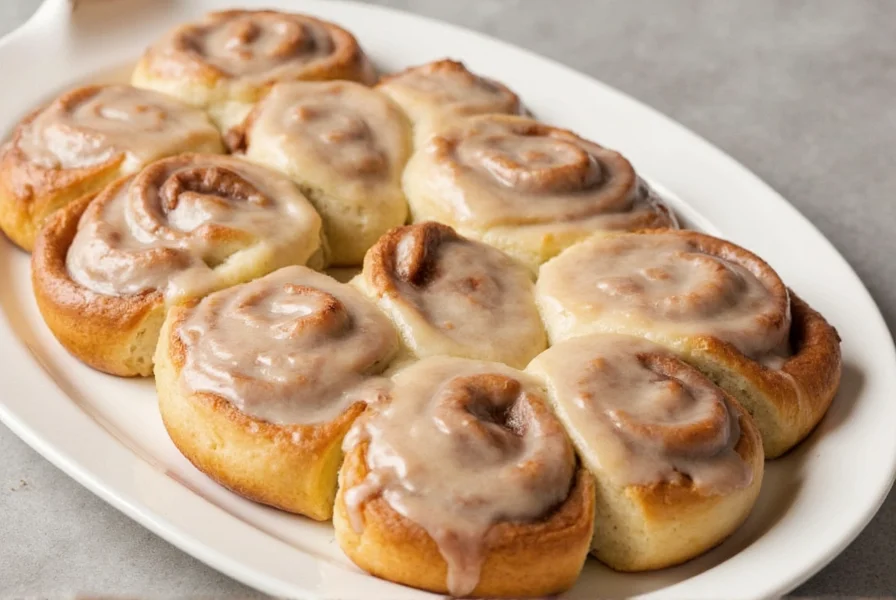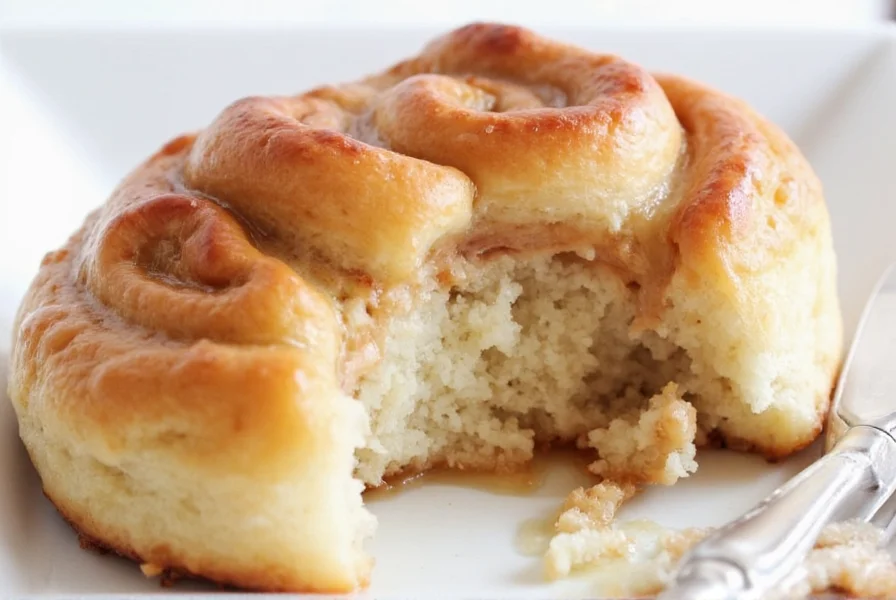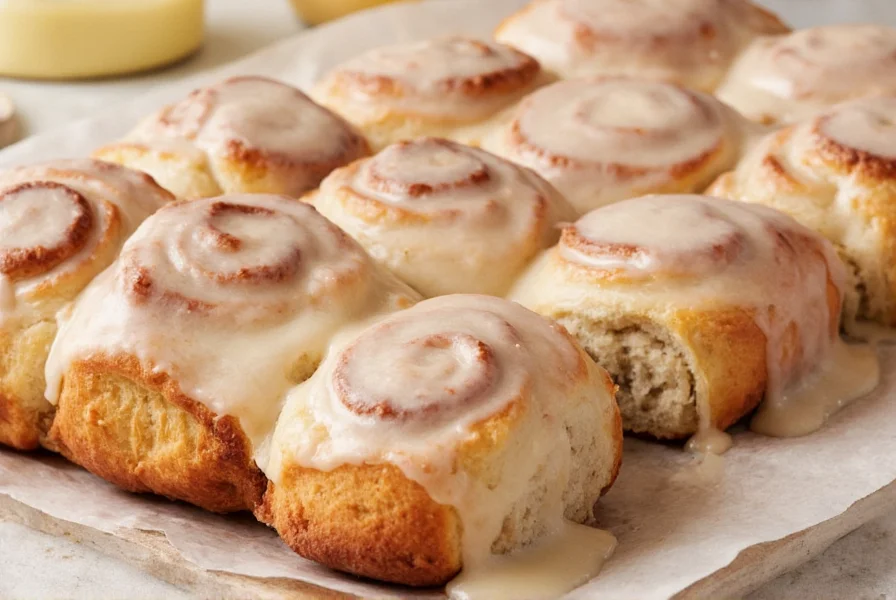Nothing compares to the aroma of freshly baked cinnamon rolls filling your kitchen, especially when topped with that perfect glossy finish. Understanding the science behind glazed cinnamon rolls transforms good pastries into exceptional ones. This comprehensive guide reveals professional techniques for achieving bakery-quality results at home, whether you're a beginner or experienced baker looking to refine your skills.
The Science Behind the Perfect Glaze
The magic of glazed cinnamon rolls happens in two critical components: the dough structure and the glaze chemistry. Yeast-raised dough requires proper gluten development to create those signature soft, pull-apart layers. Meanwhile, the glaze isn't just decorative—it serves functional purposes by adding moisture and balancing flavors.
Professional bakers emphasize that the ideal glaze consistency should coat the back of a spoon without being too runny or thick. This balance prevents the glaze from either sliding off the rolls or forming an unpleasantly hard shell. Temperature plays a crucial role—applying glaze to rolls that are still warm (but not hot) allows it to melt slightly into the surface without disappearing completely.
| Glaze Type | Key Ingredients | Texture | Best Application Temperature |
|---|---|---|---|
| Powdered Sugar Glaze | Confectioners' sugar, milk, vanilla | Semi-soft set | 110-120°F rolls |
| Cream Cheese Glaze | Cream cheese, butter, powdered sugar | Rich and creamy | 100-110°F rolls |
| Simple Syrup Glaze | Granulated sugar, water, flavoring | Thin and glossy | 120-130°F rolls |
Essential Ingredients for Homemade Glazed Cinnamon Rolls
Creating the perfect base for your glazed cinnamon rolls starts with quality ingredients. For the dough, bread flour provides superior structure compared to all-purpose flour due to its higher protein content. Fresh yeast or properly measured instant yeast ensures reliable rising. The fat component—whether butter, shortening, or a combination—affects both texture and flavor absorption.
The cinnamon filling requires attention to detail. Not all cinnamon is created equal—Ceylon cinnamon offers a more delicate flavor, while Cassia provides that familiar bold spice. For the best cinnamon roll filling ratio, professional bakers recommend 2-3 tablespoons of cinnamon per cup of sugar, adjusted to personal preference. Brown sugar adds moisture and depth compared to white sugar alone.
Step-by-Step Guide to Perfect Glazed Cinnamon Rolls
Follow these professional techniques for consistently excellent results when making homemade glazed cinnamon rolls recipe:
- Dough preparation: Mix dough ingredients until smooth and elastic. The windowpane test confirms proper gluten development—stretch a small piece of dough; if it forms a translucent membrane without tearing, it's ready.
- First rise: Allow dough to double in size at 75-80°F. Avoid rushing this process, as proper fermentation develops flavor. This typically takes 1-1.5 hours.
- Filling application: Roll dough into a 16x20 inch rectangle. Spread softened butter evenly, then sprinkle cinnamon-sugar mixture. Professional bakers recommend reserving some filling for between layers when rolling.
- Rolling technique: Roll tightly from the long side, pinching the seam to seal. Use a sharp serrated knife or unflavored dental floss to cut rolls for clean edges.
- Proofing: Allow cut rolls to rise until nearly doubled. They should spring back slowly when gently pressed.
- Baking: Bake at 350-375°F until golden brown. The ideal cinnamon roll baking temperature varies by oven type—convection ovens typically require 25°F lower temperature.
- Glazing: Prepare glaze while rolls bake. Apply when rolls reach optimal temperature as shown in the glaze comparison table above.
Common Glazed Cinnamon Roll Problems and Solutions
Even experienced bakers encounter issues with cinnamon rolls. Understanding these common problems helps troubleshoot your homemade glazed cinnamon rolls recipe:
- Tough rolls: Overworked dough or too much flour during rolling. Measure flour by weight for accuracy (450-500g per batch) rather than volume.
- Filling leakage: Apply butter thinly and use the recommended cinnamon roll filling ratio. Avoid overfilling the edges.
- Dense texture: Yeast may be expired or dough didn't proof sufficiently. Check yeast activity by blooming in warm liquid before use.
- Glaze absorption: Rolls were too hot when glazed. Wait until they cool to the proper temperature range for your chosen glaze type.
- Flat rolls: Over-proofing before baking. Rolls should increase by 50-75% during final proof, not double.
Variations for Creative Glazed Cinnamon Rolls
While traditional glazed cinnamon rolls remain popular, creative variations can elevate your baking. Consider these professional-inspired options:
- Cream cheese glaze vs powdered sugar glaze: Cream cheese adds tanginess that balances sweetness, while powdered sugar creates that classic glossy finish. Many bakeries use a combination for optimal flavor and texture.
- Flavor infusions: Add orange zest to the dough, incorporate cardamom into the filling, or use maple syrup in the glaze for distinctive variations.
- Texture enhancements: Sprinkle chopped pecans or walnuts between the layers, or add a streusel topping before baking for contrast.
- Dietary adaptations: For gluten-free versions, use a quality commercial blend and increase xanthan gum slightly. Dairy-free alternatives work well with plant-based butter and almond milk.

Storage and Reheating Techniques
Proper storage maintains the quality of your glazed cinnamon rolls. For short-term storage (1-2 days), keep them covered at room temperature. For longer storage, freezing is preferable to refrigeration, which dries out the dough.
When reheating storing glazed cinnamon rolls, professional bakers recommend:
- Thaw frozen rolls overnight in the refrigerator before reheating
- Use a microwave at 50% power for 20-30 seconds, checking frequently
- For multiple rolls, warm in a 300°F oven for 8-10 minutes
- Refresh the glaze by lightly brushing with simple syrup after reheating
Never refreeze previously frozen rolls, as this compromises texture. For best results, bake, cool, and freeze rolls before glazing, then apply fresh glaze after reheating.

Frequently Asked Questions
What's the difference between cream cheese glaze and powdered sugar glaze for cinnamon rolls?
Cream cheese glaze contains cream cheese, butter, powdered sugar, and milk, creating a richer, tangier topping that pairs well with sweet fillings. Powdered sugar glaze uses just powdered sugar, liquid (milk or cream), and flavoring, resulting in a smoother, sweeter finish that sets more firmly. Many professional bakers combine both for optimal flavor balance and texture in their glazed cinnamon rolls recipe.
Why do my cinnamon rolls come out dense instead of fluffy?
Dense cinnamon rolls typically result from improper yeast activation, over-flouring the dough, or insufficient proofing time. Ensure your yeast is fresh and activated properly in warm (not hot) liquid. Measure flour by weight rather than volume to avoid excess. Allow adequate time for both rises—dough should double during the first rise and increase by 50-75% during final proofing before baking. The ideal cinnamon roll baking temperature also affects texture; too low a temperature can prevent proper oven spring.
How can I prevent my cinnamon filling from leaking out during baking?
To prevent filling leakage in glazed cinnamon rolls, apply the butter thinly and evenly across the dough rectangle. Use the recommended cinnamon roll filling ratio (typically 2-3 tablespoons cinnamon per cup of sugar) without overloading the edges. Roll the dough tightly from the long side, pinching the seam to seal. Professional bakers often reserve some filling to sprinkle between layers as they roll. Cutting with dental floss rather than a knife creates cleaner edges that help contain the filling.
What's the best way to store glazed cinnamon rolls for maximum freshness?
For maximum freshness, store glazed cinnamon rolls at room temperature covered with plastic wrap for 1-2 days. For longer storage, freeze unglazed rolls before baking, then glaze after reheating. Refrigeration dries out the dough, so it's not recommended. When storing glazed cinnamon rolls, avoid airtight containers which can make the glaze runny. For best results, freeze rolls on a baking sheet before transferring to freezer bags, and always reheat properly before applying fresh glaze.
Can I make cinnamon roll dough ahead of time?
Yes, professional bakers often prepare cinnamon roll dough ahead of time. After the first rise, you can refrigerate the dough for up to 24 hours before rolling and filling. Alternatively, shape the rolls, place them in the pan, cover, and refrigerate overnight for a convenient morning bake. When using the refrigerator method for make-ahead cinnamon rolls, allow extra time for the final proof as cold dough rises slower. This technique actually enhances flavor development through extended fermentation.











 浙公网安备
33010002000092号
浙公网安备
33010002000092号 浙B2-20120091-4
浙B2-20120091-4